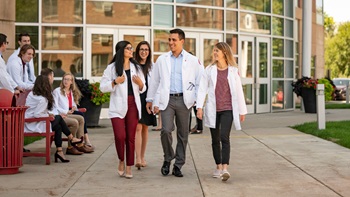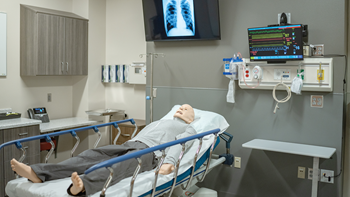Curves and Squares

The Andrew E. Lee Memorial Medicine and Science Building is so prominent and distinct in its neighborhood on the southwest edge of the University of South Dakota campus in Vermillion that it seems a singular, stand-alone aspect of the campus.
The building’s exterior certainly impresses with its size and scale, but the mid-structure atrium – the commanding, soaring space in the center of the building as well as the smaller inset glass features on both sides – dramatically ornament the building. There are, remarkably, 1,665 panes of glass on Lee Med’s exterior walls.
Each side of the atrium, as well as its roof and floor, features unique elements that are functional yet aesthetically alluring. Graceful staircases that appear to float in mid-air highlight the north end of the atrium, and suspended rail-ringed balconies are stacked on the south end. High above the third-floor balcony is an inscribed concrete plate displaying the building’s full and formal name. It is a venerable remnant from this structure’s similarly named predecessor that occupied the same site.
Look closely at the atrium’s tile floor and you’ll recognize the symmetrical pattern of a double DNA helix. The same gentle curve of the double helix design on the floor matches the curving outside edge of the walkways that overlook the atrium. Those edges are decorated by lighting fixtures that cast narrow streams of illuminated color. Who said the presentation of science can’t be creative and entertaining?
The atrium’s soaring ceiling is distinctly ribbed and arched, and at the atrium’s highest point – a tower-like protrusion that rises above the roofline to jab the sky – a striking bank of west and north-facing windows allow shafts of light to enter the space. This belt of glass should be viewed from the building’s third level to be fully appreciated.
To accommodate a diverse set of needs, the structure is divided into two critical components: the education wing, facing the west side of the atrium, and the research wing, facing the atrium from its east side. The atrium itself provides a large, open space where on the main floor large gatherings can occur and groups of students and faculty can meet and mingle.
In the southwest corner of the building’s ground floor are two expansive classrooms where Pillar 1 medical students spend much of their time learning the basic biomedical sciences. Elsewhere, there are numerous research labs, conference rooms, classrooms and offices. Occupying part of the building’s basement level is a simulation center and the medical school’s anatomy lab and classroom.
This is a building that blends simple elements to create a single, sensational whole. There are curves and squares, natural and artificial light, and brick and glass galore.



